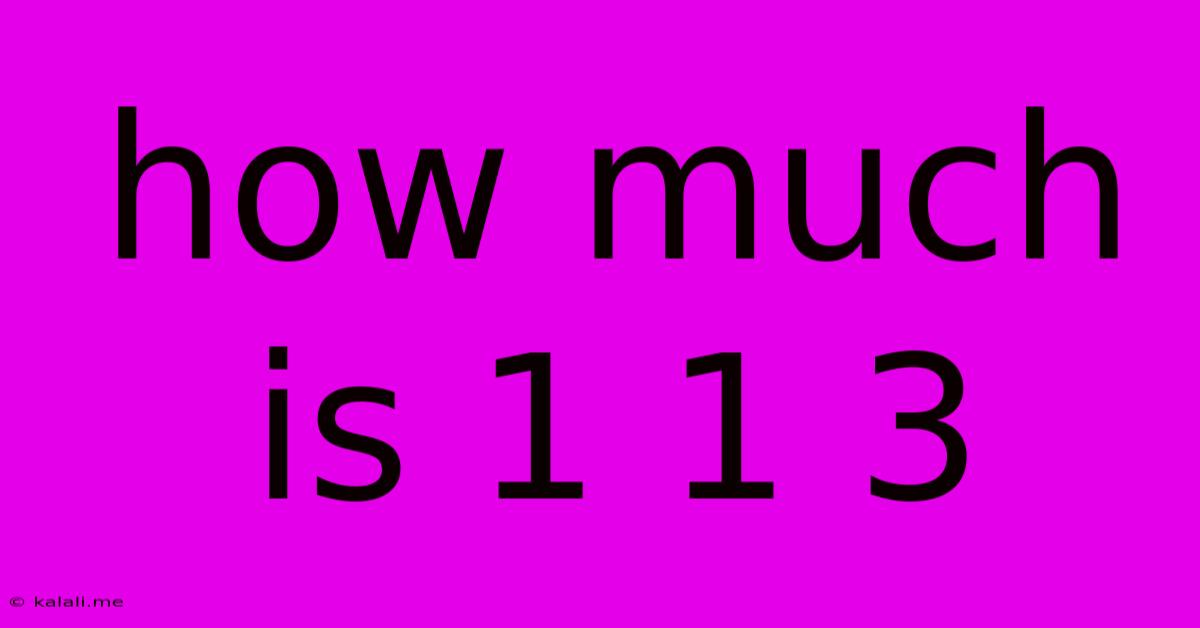How Much Is 1 1 3
Kalali
May 10, 2025 · 2 min read

Table of Contents
Decoding "1 1 3": Understanding the Ambiguity and Finding Solutions
The seemingly simple question, "How much is 1 1 3?" is actually quite ambiguous. It lacks clear mathematical operators, leaving room for multiple interpretations. This article will explore the various possibilities and provide solutions for each, clarifying the importance of precise mathematical notation. Understanding this seemingly simple problem highlights the importance of clear communication in mathematics and programming.
Possible Interpretations and Solutions
The absence of operators between the numbers introduces uncertainty. Let's explore the most likely interpretations:
1. Concatenation: Treating the numbers as a single value
This is the simplest interpretation. If we treat "1 1 3" as a single number, the answer is simply 113. This assumes the spaces are merely for visual separation and don't represent any mathematical operation.
2. Addition: Assuming "+" operators between numbers
If we assume the spaces represent addition, the problem becomes 1 + 1 + 3. In this case, the solution is straightforward: 1 + 1 + 3 = 5.
3. Other Mathematical Operations: Exploring less likely scenarios
While less likely without further context, other mathematical operations could be involved. For instance:
- Multiplication: If we assume multiplication between the numbers (though highly improbable without explicit multiplication symbols), we might interpret it as 1 * 1 * 3 = 3. However, this interpretation is far less likely given the spaces between the numbers.
- Combination of Operations: More complex scenarios involving a mixture of addition and multiplication are conceivable but require additional context or parenthesis to define the order of operations. For example, (1 + 1) * 3 = 6 or 1 + (1 * 3) = 4.
The Importance of Clear Mathematical Notation
This seemingly simple problem underscores the vital importance of using clear and unambiguous mathematical notation. The lack of operators in "1 1 3" creates ambiguity and multiple potential answers. In mathematics, programming, and any field requiring numerical precision, clear notation prevents misunderstandings and ensures accuracy. Always use the correct symbols (+, -, *, /) to indicate the intended operations between numbers. Parentheses are also crucial to define the order of operations when dealing with more complex expressions.
Conclusion: Context is Key
Without additional information or context, there's no single definitive answer to "How much is 1 1 3?". The most probable interpretations are 113 (concatenation) and 5 (addition), with other possibilities requiring explicit operators and a clear order of operations. The key takeaway is the necessity of precise mathematical notation to avoid ambiguity and ensure accurate calculations. This applies equally to simple arithmetic and more complex mathematical problems.
Latest Posts
Latest Posts
-
Words That Start With Y In Science
Jul 12, 2025
-
Prevent An Expressway Emergency By Merging Without
Jul 12, 2025
-
How Many Grams Of Sugar In A Pound
Jul 12, 2025
-
7am To 11am Is How Many Hours
Jul 12, 2025
-
If Your 35 What Year Was You Born
Jul 12, 2025
Related Post
Thank you for visiting our website which covers about How Much Is 1 1 3 . We hope the information provided has been useful to you. Feel free to contact us if you have any questions or need further assistance. See you next time and don't miss to bookmark.